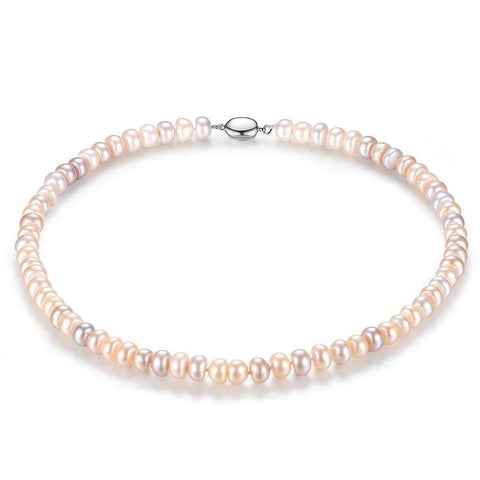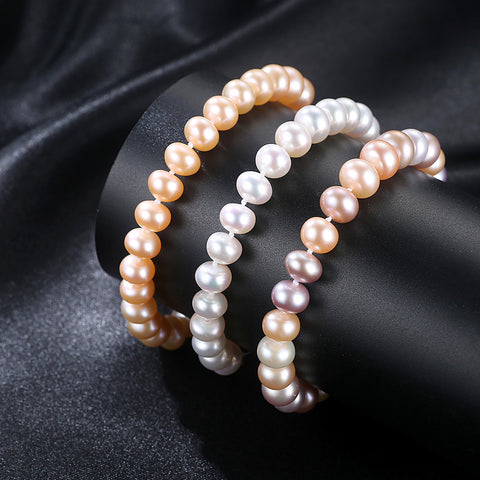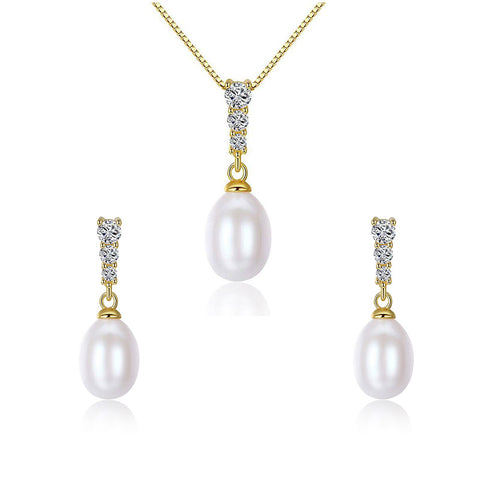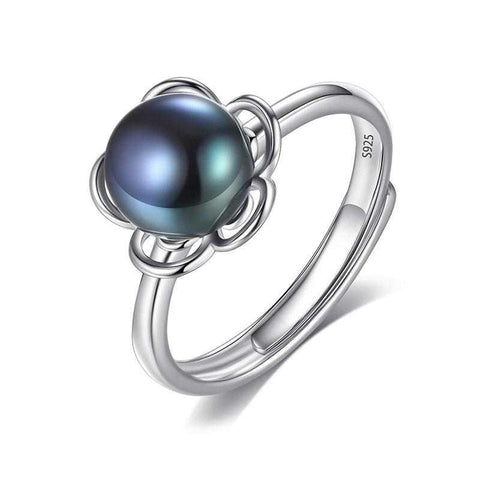
Apart from diamonds, pearls are the world's most enduring jewellery pieces. They have a timeless, classic aesthetic that adds a touch of sophistication to any outfit.
While white pearls may be the most enduring of all pearls, there are plenty of other options for those who prefer something more unique.
Depending on their color, pearls can be elegant and understated, bold, rich and earthy, or mysterious and otherworldly. We'll explore all the different pearl colors and help you choose the one that's best for you.
From elegant to everyday
Few things are as unique, elegant and culturally resonant as a string of ivory pearls. When paired with a low-neck satin gown, they're equally stunning with a white tee and mom jeans worn at the Grand Opera House or supermarket.
This June birthstone is recognisable and returns to contemporary fashion, guided by a renewed fascination with all things vintage and a fresh perspective from a new wave of millennial jewelers.
But did you know that the queen of all gems isn't always pure white? Pearls are available in a variety of colors, both natural and treated. From rich, sensual black pearls that swirl with all the colors of the Northern Lights to icy blues and shocking corals, there's a whole range of pearl colors to suit any style.
What Colors Can Pearls Be?
While you may think of pearls as white or cream, real pearls actually come in a wide range of colors. It is impossible to list the exact number of pearl colors because it depends on how you classify them.
Pears are less like a set of different boxes, more like a rainbow of overlapping colors. If you've ever seen a pearl, you know it's full of undertones and overtones of every shade. For convenience, we have divided pearls into eight categories.
Why are Pearls Different Colors?
To understand the color of pearls, we first need to understand the different color levels recognized in pearl jewelry: body color, overtone and direction.
Body color is the basic hue of the pearl as a whole, such as white, lavender, or yellow. We can think of it as our canvas.

Overtones are subtler hints of color that give pearls personality. For example, pearls may be white with a tinge of rose, or black with a tinge of green. We can consider this the first time the paint has been cleaned.
Oriental is a quality that may not be found in all pearls. This is a multi-colored iridescence similar to the rainbow effect of an oil slick. This occurs when the nacre on the pearl is particularly thick and well-shaped, and is more common with non-round or oddly shaped pearls (these are called baroque). The orient is the final layer on the canvas and it adds a little extra richness to the artwork.
The basic body color of the pearl - usually white, black or gold - depends on the type of oyster. For example, black-lipped oysters from Tahiti typically produce black pearls, while Akoya oysters, native to coastal waters of China and Japan, typically produce white pearls.
However, since each of these creatures are living things, their own shells and the colors they produce may vary as much from one person to another. The unique color of the finished pearl is mostly down to luck, and beyond that, there are artificial color treatments.
Where Do Colored Pearls Come From?
Pearls can be grown in any temperate coastal area, but the most common pearl farms are:

China, Japan, Australia, French Polynesia, new Zealand, Indonesia, Filipino.
China produces a variety of colored freshwater pearls, including pink, peach and lavender. Abundant golden South Sea pearls come mainly from the Philippines and Indonesia. Produced around the islands of French Polynesia, the deep black pearls we call Tahitians come in a range of colourful shades, from solid black to silver grey to teal.
While Japan, the birthplace of pearl farming, produces mostly white akoya pearls, we sometimes see other colors from the region, such as pale blue or champagne yellow.
What Colors Can Pearls Be?
Below, you'll learn about white, black, gold, lavender, blue, chocolate, peach and pink pearls. But even within these categories, there are endless variations. Whether you prefer a classic white, a sophisticated black, or a more exclusive pearl color like lavender or blue, there is something for you.
White Pearl
White, ivory or cream pearls are typical symbols of elegance.
Akoya, South Sea and Freshwater pearls are all white. They usually come in shades of rose, silver or ivory. White pearls are classic, versatile, and treasured from generation to generation. The most popular pearls are white Akoya pearls.
Most white akoya sea pearls come from Japan and China, with small amounts from Vietnam, Australia and Thailand. The overwhelming majority of white freshwater pearls come from Chinese pearl farms. The larger white South Sea pearls come mainly from Australia.
Black Pearl
Black pearls are much rarer than white pearls, and various myths and folklore have been built around them over the centuries. While pearls of this color have been around for a while, they have only recently become popular jewelry pieces. We all know that black is the most versatile color, but in pearls it becomes mysterious, exotic and very chic.
Black pearls are mainly grown in the French Polynesian Islands and traded in Tahiti, so they are more commonly known as "Tahitian pearls". These pearls tend to be large, approaching the size of South Sea pearls, but you can also find smaller Akoya and freshwater pearls that are color-treated to resemble Tahitian pearls.
Golden Pearl
Golden pearls are among the largest and rarest pearls in the world, as well as the most coveted. They have only been on the market since the 1970s, but quickly earned the reputation of the "Rolls-Royce" of cultured pearls. This is not surprising since they have a luxurious golden hue.

Akoya pearls and South Sea pearls are golden. If you prefer bolder, more neutral shades of gold, golden South Sea pearls are for you. While gold Akoya pearls range in color from pale lemon yellow to deep gold, with overtones ranging from green to aquamarine to violet.
They grow in the Philippines, Indonesia and Australia.
Pink Pearl / Peach Pearl
What says soft femininity better than soft pinks and peaches? These flirty colored pearls represent love and passion, but also kindness, loyalty and compassion, all of which make them the perfect romantic gift. If you want to stick with natural color pearls, freshwater pearls are your only option.
Freshwater pearls are grown in China to create beautiful pink pearls. They usually come in shades of gold, green and aquamarine. These pearls can be grown up to a size of 16mm, although they are usually between 6 and 9.5mm.
Purple Pearl / Lavender Pearl
Purple has always been one of the most popular colors in the pearl jewelry market. You can find soft lavender shades in Chinese freshwater pearls and royal purple shades in darker Tahitian pearls (sometimes called "eggplant pearls").
Natural colored lavender freshwater pearls are cultured in freshwater pearl mussels (Spinna mussels). These large pearl mussels are farmed and tended in freshwater aquaculture ponds and lakes in China. With up to 25 nucleations on each side of each shell, freshwater pearls are a very colorful affair, producing lavender, pink, peach and white pearl colors.
Blue Pearl
Perhaps the rarest color of all pearls, true blue pearls are one of the wonders of the world. Natural blue pearls come in stunning shades, from soft sky blues to deep midnight blues, and a wider range of dazzling shades.

The blue body color and overtones in pearls come from a huge spectrum. Rare Japanese akoyas come in a stunning icy blue reminiscent of winter skies, while black Tahitian pearls have an intense midnight hue.
Grey Pearl
Most white akoya sea pearls have a slight grey tint before going through the regular bleaching process. However, the more commonly sold grey pearls are Tahitian pearls. They come in a lovely silvery, stormy tin grey. Grey pearls are a bold statement and make a particularly lovely contrast to very pale hair.
Chocolate Pearl
Chocolate pearls have become all the rage lately—designers like Erica Courtney have helped cement their status as red-carpet gems. Chocolate Tahitian pearls can be colored naturally or in their signature color... guess which we prefer.

Tahitian pearls are sometimes naturally chocolate-colored, and both they and freshwater pearls can be dyed chocolate-colored. The average size is 10 to 12 mm, so these pearls are quite large.
What is the Rarest Pearl Color?
The rarest pearl color is undoubtedly the natural blue South Sea pearl. The color of nacre is usually derived from the nacre color of mollusks. However, it is believed that, unlike other pearl types, the color of blue pearls comes from a metabolic disorder in the mollusk.

Pink pearls are also among the rarest pearls in the world, as they were never successfully cultivated and only come from the queen conch. Most pink pearls you see in the market are color treated.
Which Color Pearl is the Most Expensive?
Because they are the rarest, natural blue and pink pearls tend to be the most expensive. Generally, South Sea pearls are the most expensive because the mussels that produce them can only make one pearl at a time. In contrast, freshwater mussels can make up to 30 pearls at a time.
While colored pearls are generally more expensive than classic white pearls, this is not the case when comparing cultured colored pearls to wild white pearls. Natural pearls are always more expensive due to their rarity and difficulty to find.
Also Read: How to Tell if Pearls are Real











